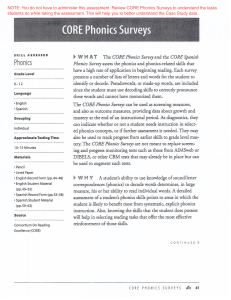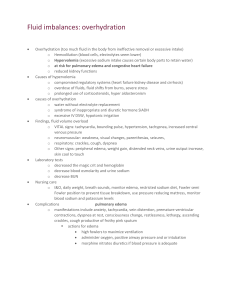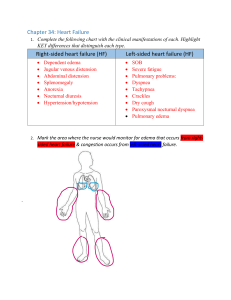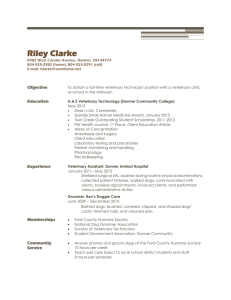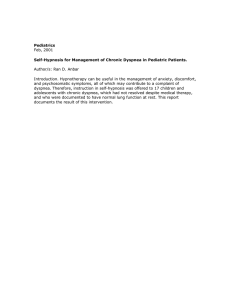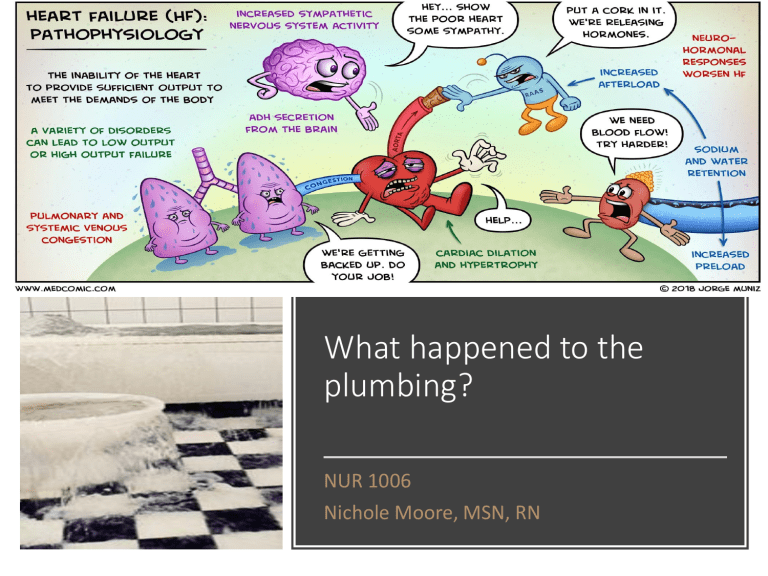
What happened to the plumbing? NUR 1006 Nichole Moore, MSN, RN Compensatory Measures - Starling’s Law The more the myocardium is stretched, the greater the force of contraction and the greater the cardiac output The greater the preload (amount of blood returning to the heart), the farther the myocardial muscle stretches, the more forceful the cardiac contraction After time or with too much resistance the heart has to pump against, the compensation methods fail to work 1. SNS Activation 2. RAAS 3. Ventricular Dilation & Hypertrophy 4. Counter-regulatory Mechanisms Mr. Donner is a 72-year-old male admitted to the cardiac unit for increasing dyspnea on exertion and fatigue Subjective Data Objective Data • History of HF for 2 years • Unable to walk one block without increasing dyspnea • Sleeps at a 60-degree angle in the reclining chair • Increasing fatigue during the last 2 weeks • BP 140/78, P = 108, R= 24, t= 98.8 (37.1) • JVD at 45 degrees • Frequent dry cough • Bilateral crackles in lung bases • Nonpitting edema • CXR – left and right ventricular hypertrophy, bilateral fluid in lower lungs 1. Explain the cause of Mr. Donner’s fatigue, cough & dyspnea. 2. Which of Mr. Donner’s signs and symptoms are from a. Left sided HF b. Right sided HF 3. Explain the purpose of each of the following therapies a. Furosemide 40 mg PO BID b. Benazepril 10 mg PO daily c. 2 g sodium diet d. 4L oxygen 4. Mr. Donner suddenly becomes dyspneic and anxious, has moist crackles throughout his lungs, and pink frothy sputum. Explain what is happening. HF - Priority Assessments or Cues HF - Priority Laboratory Tests/ Diagnostics HF - Priority Interventions or Actions HF - Priority Potential & Actual Complications Anxiety Frustration Grieving Psychosocial aspects Depression Lifestyle changes Quality of life Coping mechanisms Hope • An 89-year-old female client is admitted to the telemetry unit with a diagnosis of heart failure exacerbation. She reports a medical history of osteoarthritis and coronary artery disease including a myocardial infarction and coronary artery bypass surgery 22 years ago. She is alert and her daughter is at her bedside. The nurse’s initial client assessment findings include • Oriented to person only • Clear speech • Follows simple commands • Has sinus tachycardia • Respirations = 26 breaths per min • Oxygen saturation = 90% (room air) • Breathing labored with use of accessory muscles • Has productive cough with pink frothy sputum • Crepitus in bilateral knee joints • Enlarged bony nodes on hands • Hemoglobin = 12.4 g/dL • Hematocrit = 39% Indicate which nursing action listed in the far-left column is appropriate for each potential heart failure complication. Note that not all actions will be used. Nursing Action Potential Heart Failure Complication 1. Reduce sodium intake to 1 g daily Acute pulmonary edema 2. Administer oxygen therapy Hypokalemia 3. Weight the client each morning on the same scale Hypoxemia 4. Administer furosemide 20 mg intravenous push 5. Teach the client pursed-lip breathing techniques 6. Administer potassium supplements 7. Reposition every 2 hours while in bed Appropriate Nursing Action for Each Potential Heart Failure Complication For each assessment finding, use an X to indicated whether the interventions were Effective (helped to meet expected outcomes), Ineffective (did not help to meet expected outcomes), or Unrelated (not related to expected outcomes). Assessment Finding States she has no shortness of breath since hospital discharge Has 2+ pitting edema in both ankles and feet Blood pressure = 128/76 mm Hg Has had no chest pain since hospital discharge Reports feeling like she has more energy now when compared with before her hospital stay Has new-onset fungal skin infection Effective Ineffective Unrelated
